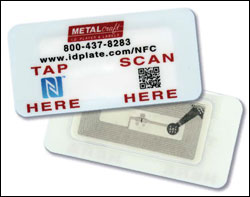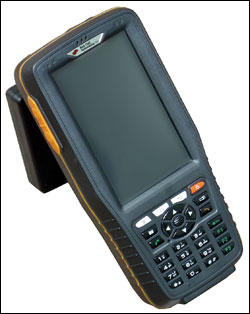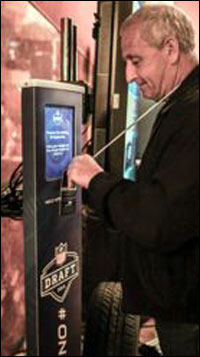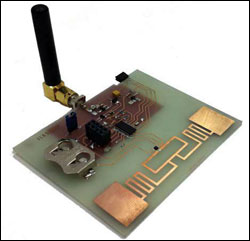The following are news announcements made during the past week by the following organizations:
Convergence Systems Ltd.;
MetalCraft;
Red Cell Innovation; the
National Football League, Fish Technologies; the
University of Salento, RAMSES;
NXP Semiconductors, and the ZigBee Alliance.
Mapúa Institute of Technology Library Adopts CSL UHF RFID Technology
Convergence Systems Ltd. (CSL), a global provider of passive radio frequency identification products and active real-time location system (RTLS) equipment, has announced that the Mapúa Institute of Technology, located in the Philippines, has implemented an ultrahigh-frequency (UHF) RFID solution provided by CSL and ClarIDy Solutions to automate processes at its library. Mapúa Institute implemented the company’s IDSmart library solution early this year at its Intramuros campus in Manila, according to ClarIDy, which employs CSL UHF readers at self-service stations, self-return stations and security gates. Many libraries around the world use RFID solutions to streamline check-in and checkout processes and other library applications, but most leverage RFID based on high-frequency (HF) RFID passive tags and systems operating at 13.56 MHz. Fewer use UHF passive RFID tags based on the EPC Gen 2 standard that Mapúa Institute is deploying. “Increasingly,” said Jerry Garrett, CSL’s managing director, in a prepared statement, “libraries are switching to UHF RFID frequencies because the UHF tags cost less than HF tags, and the read ranges for UHF are much greater than those offered by HF technology.” CSL is providing the readers and tags, while ClarIDy’s IDSmart system leverages the RFID tags, which are encoded with the library’s existing automation system data and are affixed inside the books. With these tags in place, CSL reports, the library books can be inventoried, and be checked in and out, using a portable inventory reader, self-service library checkout station, self-return station or book drop. There are also RFID security gates to ensure that books have been properly checked out before they leave the library. “The objectives are to improve the workflow processes in our libraries, to solve inventory problems, and to save time,” said Emerald L. Lansangan, Mapúa’s chief knowledge officer, in the prepared statement. “With this efficient UHF RFID system in place, faculty members and students can now expect faster and shorter queues when borrowing and returning library materials, and librarians are free to focus on assisting our students with their research queries.” Due to the success of the UHF RFID system deployed at the university’s Manila campus, the Mapúa Institute of Technology plans to install this library solution at its Makati City campus as well.
Metalcraft Announces NFC Tags
Metalcraft has announced the availability of new Near Field Communication (NFC) RFID tags that can be used with NFC-enabled cell phones and provide secure data exchange at distances of less than 20 centimeters (7.9 inches). The 13.56 MHz passive tags measure 2 inch by 1 inch (with optional sizes available) and support the ISO 14443 standard. The label copy may include block type, stylized type, logos or other designs. All copy, block type, stylized type, logos, designs and bar codes are subsurface–printed—a process that, according to Metalcraft, provides resistance to solvents, caustics, acids and moderate abrasion. Any information printed on the bar code in human-readable text can also be pro-encoded onto the RFID inlay, as long as the data is in decimal or hexadecimal (A-F, 0-9) format, and Metalcraft can custom-encode information to the Electronic Product Code (EPC) and user memory banks. Additionally, Metalcraft can encode data that differs from the bar-code and human-readable information. The inlay adheres to a durable, flexible polyester label with subsurface printing that protects bar-code, logo and other printed information, Metalcraft adds. The polyester label is 0.002 inch in thickness and is backed with a permanent pressure-sensitive adhesive. The tag is designed to withstand temperatures ranging from -40 degrees to +300 degrees Fahrenheit (intermittent) and has a shelf life of 24 months when stored at 72 degrees Fahrenheit (22 degrees Celsius) and 50 percent relative humidity.
Red Cell Innovation Unveils Handheld PDA With RFID
Red Cell Innovation Inc., a Canadian company specializing in developing integrated hardware and software that leverages RFID, telemetry, sensing and other technologies, has announced a new industrial handheld mobile phone and personal digital assistant (PDA) that can support both RFID and bar-coding. The ST-308 Industrial Android PDA consists of a base unit that can be combined with an RFID reader-writer. Options include a reader complying with the 13.56 MHz high-frequency (HF) ISO 14443 standard and versions that comply with the ultrahigh-frequency (UHF) EPC Gen 2 standard, offering a 50-centimeter (19.7-inch), 200-centimeter (78.7-inch) or 300-centimeter (118-inch) read range. A 1D laser, 2D laser or CCD bar-code reader option can also be added. The base unit includes a 1.2 GHz processor, 1 gigabyte of random access memory (RAM), 8 gigabytes of built-in FLASH storage that is expandable with a Micro SD card slot, a 10-centimeter (4-inch) IPS LCD touchscreen with 480 by 800 (WVGA) pixel resolution (HDPI), a 33-key numeric keypad, a 5-megapixel camera with flash, a flashlight, a USB 2.0 port and an RJ45 jack for 100Base-TX Ethernet. It includes support for 3G cellular telephony (most North American carriers are supported, the company notes), as well as GPS, Bluetooth V2.0 Class II and 802.11b/g/n Wi-Fi. The ST-308 base unit also comes with headphones, a stylus, a carrying case and a wrist strap. According to Red Cell Innovation, the device has an IP 65 rating, meaning that testing has confirmed it to be dustproof and waterproof, and weighs 350 grams (12.3 ounces) for the base unit and 500 grams (17.6 ounces) fully loaded. The 8000mAh battery can be used for 10 hours, or sit on standby for up to 20 days, the company reports. The base model is priced at $600, while a unit with a bar-code scanner and RFID costs about $1,000, according to Red Cell Innovation.
NFL Draft Picks Fish Technologies
Fish Technologies has announced that during the 79th National Football League (NFL) Draft, held last month at Radio City Music Hall in New York City, its RFID-enabled solution was used to provide fans in attendance with a variety of NFL and brand content, special offers, promotions and shared experiences via social media. Fish Technologies’ solution leverages RFID-enabled kiosks and RFID-enabled credentials that support either ultrahigh-frequency (UHF) EPC Gen 2 standard or high-frequency (HF) technologies (such as Mifare, Tag-it and Icode tags). The solution is not limited to a specific brand, but Fish Technologies’ current partner supplier is Precision Dynamics Corp. (PDC), according to Rick Weldon, Fish Technologies’ president. For the RFID readers, the solution leverages a proprietary UHF reader for the Fish Track Tower—a kiosk that can be used by event attendees, and that also enables the event organizer to track active attendee engagements and measure attendee engagements. For tablets used with the solution, Fish Technologies leverages the RFID ME and RFID Mini ME readers from Microelectronics Technology Inc. (MTI). During the NFL Draft show, EPC Gen 2 RFID tags and readers were used, Weldon reports. Fans at the show needed only to register once; their RFID-enabled credential could then be used throughout the multiday event. The NFL Draft included a pre-registration website, a platform for registering credentials via a fan’s own mobile phone, 10 interactive RFID kiosks that allowed fans to request content and post messages to social networks, 30 Microsoft Surface Tablets, and numerous photo interactive experiences installed throughout Radio City Music Hall. In a prepared statement, Aidan Lyons, the NFL’s VP of fan-centric marketing, said that the RFID-enabled solution allows fans to spend less time standing in lines filling out forms, and more time engaging with brands and collecting NFL content. “For us it is all about the fans, and giving them an enhanced experience,” Lyons said in the statement. Fish Technologies’ RFID solution has been used at other events as well, including the 2013 Australian Open (see RFID Scores High at Australian Open).
University of Salento Researchers Develop RAMSES Passive RFID Sensor Tag
Since 2005, the RFID division of the ElectroMagnetic Lab Lecce (EML²) at the University of Salento, in Italy, has been proposing RFID-based sensor solutions. Recently, Danilo De Donno, a postdoctoral researcher at EML², announced that he—working under his advisors, Luciano Tarricone and Luca Catarinucci—has developed a prototype EPC Gen 2 ultrahigh-frequency (UHF) RFID sensor tag that extends the range necessary for the tag to harvest the RF energy emitted by an interrogator. RAMSES (RFID Augmented Module for Smart Environmental Sensing) is designed as a fully passive RFID device with sensing and computation capabilities. In a paper slated for publication in the July 2014 issue of IEEE Transactions on Instrumentation and Measurement, the researchers write that the tag prototype is fabricated on a printed circuit board using low-cost, off-the-shelf discrete components, and has been extensively tested through experiments conducted both in lab and real-world application scenarios. The results, they report, demonstrate RAMSES’ ability to harvest the RF energy emitted by an interrogator placed up to 32.8 feet (10 meters) away and autonomously perform sensing, computation and data communication. The researchers believe that this is the longest range ever reported for fully passive RFID sensors. For applications requiring larger operating distances, RAMSES can operate in a battery-assisted passive (BAP) mode, extending the communication range to 22 meters (72 feet). The prototype tag employs Impinj‘s Monza X-2K RFID chip with a dual interface: a wired I²C interface managed by an ultra-low-power TI MSP430 microcontroller unit (MCU) and a wireless EPC Gen 2 UHF RFID interface for communicating with the reader. RAMSES is self-powered by an RF energy-harvesting circuit enhanced by a DC-DC charge pump in silicon-on-insulator (SOI) technology, but it is also equipped with a CR2032 lithium battery for battery-assisted passive (BAP) operations. RAMSES’ available sensors comprise a temperature sensor, an ambient light sensor, a pressure sensor and a three-axis accelerometer. The researchers are offering firmware for download at the RAMSES wiki website. De Donno, who is carrying out postdoctorate work at the University of Salento’s Department of Innovation Engineering, and is RAMSES’ designer and principal investigator, says he would like to encourage students and researchers involved in academic projects, as well as electronics hobbyists and developers, to include RFID functionalities in their projects and PCB designs. “For these reasons, I decided to offer RAMSES firmware and code examples for download to the general public,” De Donno states. “I think that such kind of initiatives can bring a lot of benefits to the RFID community and expand diffusion, knowledge, and potentialities of the RFID technology.” Do Donno says he plans to continue improving RAMSES by adding additional sensors and solar energy-harvesting capabilities through what he describes as a novel DC power-summation network. “In the last few years,” he reports, “monitoring the environment, capturing significant events and interpreting physical space information with sensors have been increasingly demanded in several application fields, such as disaster prevention and recovery, surveillance, home automation, health care, structure and machine diagnosis, advanced traceability systems.” However, he notes, current IEEE 802.15.4-based wireless sensor networks (WSN) have a lifetime measured in weeks or months, which is generally unsuitable for long-lived applications requiring truly unobtrusive sensing. “In my opinion, RFID technology, recently maturated and enhanced by computational RFID sensor tags (e.g., RAMSES), has a number of key aspects, such as small form factor, zero-power backscatter communication, and standardized EPCglobal identification of nodes (tags), that make it a promising candidate to supplant or complement existing WSN.” RAMSES schematics and PCB fabrication files will be released shortly on the wiki website, De Donno adds.
NXP Semiconductors Joins ZigBee Alliance Board of Directors
The ZigBee Alliance has announced that NXP Semiconductors is now a new member of the organization’s board of directors. The ZigBee Alliance is an association of companies working to define ZigBee standards, provide interoperability and conformance testing specifications, and promote the technology’s adoption. NXP had already been a member of the ZigBee Alliance, and has been active in ZigBee standards development prior to joining the board of directors, explained Pieter Hooijmans, NXP’s VP of R&D BU security and connectivity, in a prepared statement. The new role, Hooijmans added, is “a logical next step in our relationship.” Among its many product offerings, NXP supplies microcontrollers and transceivers for smart homes, connected lighting and energy efficiency applications based on ZigBee standards. NXP has also developed a variety of ZigBee-certified platforms and reference designs for key markets, including energy efficiency, connected devices, security and health, the company reports. NXP joins Comcast Cable, Freescale Semiconductor Inc., Itron Inc., Kroger, Landis+Gyr, Legrand Group, Philips Electronics, Schneider Electric, Silicon Labs and Texas Instruments on the ZigBee Alliance board of directors. “NXP’s addition to the ZigBee Alliance Board is a significant endorsement of the strategic leadership ZigBee plays in the marketplace for the Internet of Things,” said Tobin J. M. Richardson, the ZigBee Alliance’s president and CEO, in the prepared statement. “NXP’s commitment to open, global standards and its portfolio of innovative products will help spread adoption of ZigBee standards and promote Internet of Things applications around the world.”





